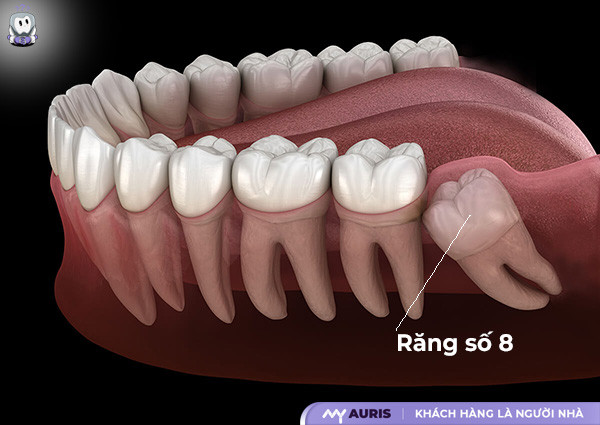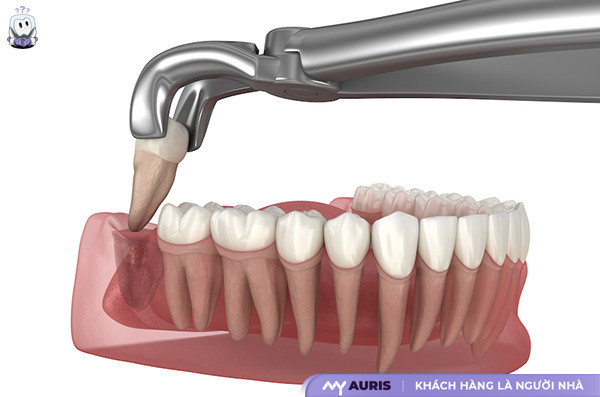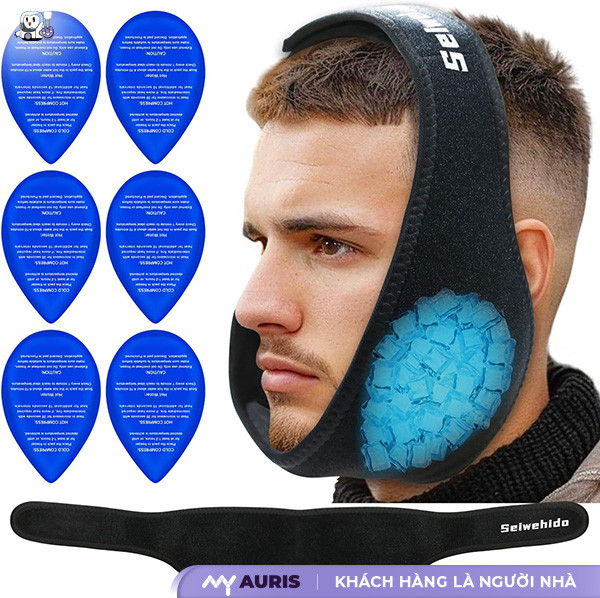Over 90% of the global population owns tooth number 8 – also known as wisdom teeth. Normally, each person will grow from 1 to 4 wisdom teeth between the ages of 17 and 25. However, because wisdom teeth often grow crooked, grow underground, causing pain, inflammation or affecting neighboring teeth, many people are forced to have them removed to protect long-term oral health.
What is tooth number 8?
Tooth number 8 is the last tooth to grow in an adult’s teeth, usually appearing between the ages of 17 and 25. This tooth number 8 is also called wisdom tooth, because it grows when a person has entered the stage of adulthood. Each person can grow from one to four number 8 teeth, located at the ends of the lower and upper jaws. In some cases, this tooth may not erupt or grow underground under the gums.
Tooth number 8 belongs to the group of large molars, but unlike other molars, it does not have corresponding milk teeth when it is young. When growing, this tooth tends to grow crookedly, grow underground, or be crowded with other teeth. That can easily cause gingivitis, jaw swelling, and prolonged pain. Because it is located deep in the chewing system, cleaning tooth number 8 is very difficult, which can easily lead to tooth decay, periodontitis and other complications.

When does tooth number 8 start to grow?
Normally, wisdom teeth begin to grow from 18 to 25 years old, however there are cases of teeth growing as early as 16 years old or later up to 30 years old. The growth process can last several months or years depending on the jaw structure, jaw end position, and each person’s chewing system.
Some people will never grow tooth number 8. This is a normal phenomenon and does not affect chewing function, because this tooth does not support the chewing function like the remaining large molars. Some people can even grow two number 8 teeth on one side, causing bite disorders or increasing the risk of misaligned teeth and gingivitis.
Signs to recognize that tooth number 8 is starting to grow
When tooth number 8 begins to emerge, you may feel:
- Pain at the end of the jaw
- Jaw swelling, difficulty opening mouth
- Slight tear in the gums, due to gum recession.teeth pierced
- Teething causes mild fever, headache, fatigue
These symptoms usually last a few days to a few weeks. In case of impacted or misaligned teeth, toothache number 8 can become a long-lasting, persistent pain. At that time, you need to go to the maxillofacial clinic so that the dentist can check with X-rays and determine the treatment direction.
Why does teeth number 8 cause pain?
Teething tooth number 8 causing pain is a common condition in adults. This is the last tooth to grow in the permanent tooth set, usually appearing between the ages of 18 and 25. Due to late growth, there is not enough space left on the lower or upper jaw, so tooth number 8 is susceptible to growing crookedly, underground, or penetrating horizontally. This leads to prolonged pain, affecting the chewing system and overall health of adult teeth.
Is tooth number 8 crooked or impacted?
A misaligned tooth number 8 can compress tooth number 7, causing prolonged pain, misaligning the bite, and putting pressure on the lower or upper jaw depending on the position. If impacted, this tooth can cause jaw swelling, sharp pain, gingivitis, or deep inflammation under the gums. In severe cases, widespread infection can affect the mandibular nerve or cause jaw bone loss. These complications are not only painful but also pose a high risk if not handled promptly by a dentist.
If you have tooth number 8 that is crooked or impacted, proactively visit the maxillofacial clinic to get X-rays and accurately assess the tooth position. Depending on the degree of deviation and impact, the dentist may prescribe monitoring or performing minor surgery on tooth number 8. In most cases, extracting tooth number 8 is a safe measure to prevent complications such as periodontitis, abscess or jaw bone loss.
Pain in tooth number 8 What medicine to take effectively
Using the correct medicine not only helps relieve pain but also limits complications, especially while waiting for minor surgery on tooth number 8.
Over-the-counter pain relievers
Paracetamol: This is a safe choice, suitable for most adults. The usual dose is 500mg, taken every 4–6 hours, not more than 4g per day.
Ibuprofen: Both pain reliever and mild anti-inflammatory. Usually a dose of 200–400 mg every 6–8 hours. Note: Do not use if you have stomach disease.
Naproxen: The effect lasts longer than Ibuprofen, but you need to consult a doctor before using.

Antibiotics (only used when there are signs of inflammation)
Amoxicillin: Indicated if there is swelling, pus or gingivitis. Usually use 500mg, 2-3 times a day, lasting 5-7 days.
Metronidazole: Often used in combination with anaerobic infections.
Some products such as gels contain benzocaine to help temporarily numb gum area. Apply directly to the painful area, avoid swallowing.

Should tooth number 8 be removed
In most cases, dentists recommend extracting tooth number 8 when it is crooked, impacted, or does not have a clear chewing function. Tooth number 8 usually does not participate in the chewing system and has a high risk of causing periodontitis, jaw bone loss or affecting the mandibular nerve. When extracted at the right time, you will avoid serious complications and recover faster. Minor surgery on tooth number 8 is now performed safely, with little pain and heals quickly with appropriate care.
In cases where tooth number 8 should be extracted
Tooth number 8 grows crooked or impacted: If the wisdom tooth grows diagonally, tilted, or does not fully emerge from the gums, it can push tooth number 7, creating pressure and causing bite disorders. This affects the entire adult teeth and the dental-maxillo-facial system.
Causes prolonged pain or gingivitis: Teething number 8 causes prolonged pain, which is a warning sign of inflammation. If accompanied by jaw swelling, difficulty opening the mouth, fever or pus, immediate surgery is needed to avoid spreading infection.
Affects the jaw structure or nerves: In some cases, tooth number 8 grows deep below the lower jaw, near the lower jaw nerve. If not treated, it can cause nerve damage, lip numbness, and loss of feeling in half of the face.
Does not have a chewing function and easily accumulates bacteria: Wisdom teeth usually do not participate in the chewing function, and are located at the end of the jaw, which is difficult to clean. This condition easily leads to tooth decay and periodontitis in both tooth number 8 and adjacent tooth number 7.
When does tooth number 8 need to be extracted?
Teeth growing straight, without causing pain: If wisdom teeth grow in the right direction, are not covered by gums, do not block adjacent teeth and are easy to clean, you can keep them. However, you need to periodically monitor with a dentist to ensure there are no complications. later.
People with unstable systemic diseases: Patients with cardiovascular disease, diabetes or blood clotting disorders need to consider carefully before extraction. In this case, the doctor will coordinate with other specialists for safe treatment.
Teeth not yet grown but no signs of pain: Some people can have wisdom teeth completely embedded in the bone without causing any symptoms. In this case, you only need to take regular radiographs to control, no need to intervene immediately.
Tooth extraction process no. 8 at the dentist
Step 1: General examination and X-rays
The doctor conducts a general oral examination to determine the condition of tooth number 8. Next, take X-rays to help determine the exact position of tooth number 8 in the lower or upper jaw. The degree of misalignment, affecting tooth number 7, the mandibular nerve or the jaw bone. 400;”>After evaluating the film, the doctor will give detailed advice on the condition of tooth number 8, the risk of gingivitis, periodontitis, wisdom tooth pain or jaw swelling. The patient is carefully explained about the minor surgical procedure, dental tools used, procedure time and healing time. Here, the patient is also instructed to prepare for health such as eating lightly before extraction, getting enough rest, and avoiding anticoagulants (if indicated).
Step 3: Anesthetize tooth number 8
The doctor uses local anesthesia to reduce pain. Thanks to modern anesthesia technology, most patients do not feel pain during the extraction process. This is a factor that helps ensure the tooth extraction is painless and safe for the patient Some large maxillofacial clinics can use automatic anesthesia machines to accurately control the dosage.
Step 4: Perform minor surgery to extract tooth number 8
The doctor makes an incision in the gums (if necessary), dissects the tissue and uses specialized equipment to loosen tooth number 8. In many cases of crooked teeth or impacted teeth, the doctor will divide the tooth into small parts to remove each part. This is a common technique when removing wisdom teeth that are impacted in the jaw bone. After removing the tooth, the doctor cleans the tooth socket, removes inflammation and examines the surrounding nerves.
Step 5: Suture the wound and care instructions
Finally, the doctor sutures the soft tissue ifNeed and have the patient bite on gauze to stop the bleeding for 30 minutes. After that, the patient is instructed to use pain relievers such as Paracetamol, anti-inflammatory drugs such as Amoxicillin, and other notes in daily life. This stage is extremely important to prevent infection after tooth extraction and promote quick recovery.
Step 6: Follow-up appointment
After 5 to 7 days of extraction, the patient needs to return to the clinic to check the wound. Your doctor will evaluate your wound’s healing status, remove sutures if they are non-absorbable, and provide follow-up care instructions. If swelling, fever or prolonged pain is detected, the patient needs to be re-examined soon to prevent complications.

How to care after tooth extraction no. 8
Patients need to have practical, specific knowledge and comply with the dentist’s instructions to avoid infection after tooth extraction, jaw swelling or jaw bone loss.
After extraction, the dentist will place sterile gauze in the cavity position. teeth. You need to bite down on the gauze for about 30–45 minutes to help the blood clot form. Absolutely do not spit or gargle vigorously within the first 24 hours because this can easily dislodge blood clots, leading to prolonged bleeding and exposing the jawbone, causing pain.
In the first 6–12 hours after tooth extraction, you should apply a cold compress to the outside of the cheek at the position corresponding to the extraction area. This helps reduce swelling and pain effectively. Each compress lasts 10–15 minutes, with a break of about 20 minutes between sessions. Absolutely do not use hot water because it can dilate blood vessels and increase bleeding.
Do not exercise vigorously, exercise or bend suddenly after tooth extraction. Pressure on the chewing system, especially the lower jaw, will easily injure the area that has undergone minor surgery. When sleeping, you should elevate your head to avoid blood pooling in the newly extracted area.
Most patients will be prescribed painkillers Paracetamol, antibiotics Amoxicillin and non-steroidal anti-inflammatory drugs to prevent infection and reduce swelling. Do not arbitrarily buy medicine without prescription. If you have severe pain in tooth number 8 after 2-3 days of extraction, you need to have a follow-up examination to check the risk of dry socket inflammation.
On the first day, you should eat liquid foods such as porridge or cold soup. Do not use foods that are hot, spicy, hard, or have small particles that can easily get stuck in the tooth socket. After 48 hours, you can switch to soft foods such as crushed rice or noodles, avoid chewing towards tooth number 8. Avoid using a straw or smoking because it can easily lose blood clots.
Rinse your mouth with physiological saline after 24 hours from the time of extraction. Use a soft brushBrush gently to avoid touching the newly extracted area. Thoroughly clean the area of tooth number 7 and adjacent molars to avoid spreading bacteria. Absolutely do not use toothpicks or sharp objects into the tooth socket.
After extraction, if there are signs such as pain lasting more than 3 days, bad breath, fever, continuous bleeding or swelling on one cheek, you need to go to the dental clinic immediately. This can be a sign of dangerous complications such as periodontitis, gingivitis or widespread infection.
Normally, the doctor will request a follow-up examination after 5–7 days to check the healing of the wound and clean the extraction area. In some cases, it may be necessary to remove the sutures if stitched with non-absorbable sutures. This is a necessary step to ensure you do not have wisdom teeth grow out, have hidden infections or affect the neighboring molars.
Frequently asked questions about tooth number 8
Does tooth number 8 need to be X-rayed
Taking an X-ray of tooth number 8 is necessary in most cases. Film images help dentists determine the exact position, direction of growth and the degree of impact of teeth on neighboring structures in the dento-maxillo-facial system.
The process is quite fast. When you go to the dental clinic, the doctor will use a full-mouth X-ray machine or a close-up of tooth number 8. The images are processed within a few minutes. The cost of shooting is also reasonable, ranging from 100,000 – 300,000 VND, depending on the type of film.
Is it possible to have 2 number 8 teeth extracted at the same time
Extracting two wisdom teeth at the same time is completely possible if you are in good health and performed by a highly specialized dentist. In fact, many people have teeth number 8 growing symmetrically on both sides of the jaw and need to be extracted. At that time, the dentist can prescribe simultaneous extraction to save treatment time, reduce the number of times of medication and avoid prolonged pain.
However, it is necessary to distinguish between the extraction of 2 teeth on the same side (left or right) and the extraction of 2 symmetrical teeth on both sides. In the case of extraction on the same side, you will have difficulty chewing food afterward because you lose both the upper and lower teeth at the same time. Therefore, many dentists will prioritize extracting 1 tooth on the right and 1 tooth on the left to ensure temporary chewing function.
Some factors to consider before extracting 2 teeth at the same time:
- No medical history such as diabetes, cardiovascular disease, blood clotting disorders
- Severe misaligned teeth, causing long-term pain
- Have a suitable post-extraction care plan
After extraction, it is necessary to apply proper post-extraction care such as applying cold compresses, limiting chewing on the extraction side, and using toothpaste.Paracetamol or Amoxicillin antibiotic according to doctor’s instructions.

Does tooth number 8 that grows straight require regular monitoring? period
Even though tooth number 8 is growing straight and not causing trouble, you should still actively monitor it. The chewing system and permanent teeth need long-term care, and complications should not be treated until complications arise.
Effective ways to monitor tooth number 8 include:
- Regular dental examination every 6 months
- Take regular films if there are changes
- Clean your teeth last with a specialized toothbrush
- Rinse your mouth after eating and use dental floss
Tooth number 8, also known as wisdom tooth, is the last permanent tooth to grow in the jaw. However, their appearance often leads to many troubles and has the potential to cause serious oral health problems such as gingivitis, tooth decay or misaligned teeth. Understanding the characteristics of wisdom teeth as well as grasping important related notes will help you be proactive in care, treatment and make the right decision about whether to remove tooth number 8 or not.





